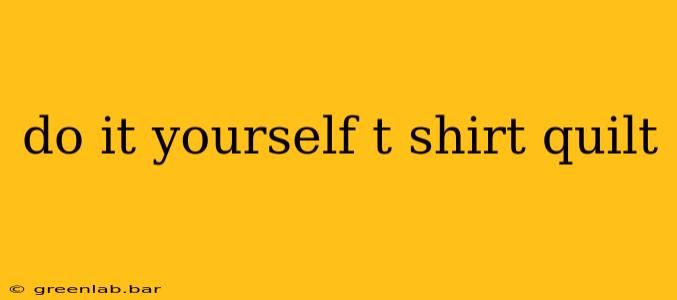Turning your collection of cherished t-shirts into a cozy, one-of-a-kind quilt is a rewarding project. Whether you're a seasoned quilter or a complete beginner, a DIY t-shirt quilt offers a unique way to preserve memories and create a beautiful, personalized piece for your home. This guide explores both no-sew and sewn methods, empowering you to choose the approach that best suits your skill level and desired outcome.
Choosing Your T-Shirts: A Foundation of Memories
Before diving into the construction, selecting your t-shirts is crucial. Consider these points:
- Variety is Key: A mix of colors, designs, and prints creates visual interest. Don't be afraid to include shirts with sentimental value, even if they don't perfectly match aesthetically.
- Fabric Condition: Choose shirts in good condition; avoid those with significant fading, stretching, or holes. Pre-wash all shirts to prevent shrinkage after the quilt is complete.
- Quantity: The number of shirts determines the quilt's size. Plan accordingly, considering the desired dimensions and the size of your individual t-shirt squares.
Method 1: The No-Sew T-Shirt Quilt – Easy and Accessible
This method is perfect for beginners or those who want a quicker, simpler approach. It relies on fabric glue or fusible interfacing for assembly, eliminating the need for sewing.
Materials Needed:
- Chosen t-shirts
- Fabric glue (specifically designed for fabric) or fusible interfacing
- Quilt batting (choose a thickness based on your preference)
- Backing fabric (consider a coordinating color or a solid neutral)
- Scissors or rotary cutter and mat
- Iron and ironing board (for fusible interfacing)
- Measuring tape or ruler
Step-by-Step Instructions:
- Prepare the T-shirts: Cut your t-shirts into squares or rectangles of consistent size. Consider the design placement on each shirt to maximize visual impact.
- Arrange the Squares: Lay out your squares on a flat surface to create your desired quilt layout. Experiment with different arrangements until you’re satisfied.
- Adhere the Squares: If using fabric glue, carefully apply it to the back of each square and adhere it to the batting. If using fusible interfacing, follow the manufacturer's instructions for application.
- Attach Backing: Once all squares are attached to the batting, carefully position and glue or fuse the backing fabric to the back.
- Finishing Touches: Trim any excess fabric. You can add a decorative border if desired. Consider using bias tape for a neat finish.
Method 2: The Sewn T-Shirt Quilt – A More Durable Option
For a more durable and traditional quilt, sewing offers a stronger, longer-lasting result.
Materials Needed:
- Chosen t-shirts
- Sewing machine (or needle and thread for hand-sewing)
- Quilt batting
- Backing fabric
- Thread (matching or contrasting colors)
- Scissors or rotary cutter and mat
- Measuring tape or ruler
- Pins
- Sewing machine needles suitable for jersey fabric
Step-by-Step Instructions:
- Prepare the T-shirts: Cut your t-shirts into squares or rectangles. Consider using a serger or zig-zag stitch to prevent fraying.
- Arrange and Sew: Arrange the squares as desired and sew them together, row by row. Press the seams open.
- Layer and Quilt: Layer the top (assembled squares), batting, and backing fabric. Baste the layers together. Quilt the layers together using your preferred quilting technique.
- Bind the Quilt: Finish the edges of the quilt by binding it with fabric binding or a contrasting fabric strip.
Tips for Success:
- Pre-wash your fabrics: This essential step prevents shrinkage and ensures colorfastness.
- Use sharp scissors or a rotary cutter: Clean cuts are essential for a professional look.
- Take your time: These projects require patience and attention to detail. Don't rush the process.
- Consider adding embellishments: Personalize your quilt further with embroidery, patches, or other decorative elements.
Conclusion: A Legacy of Love and Memories
Creating a DIY t-shirt quilt is a labor of love, resulting in a cherished heirloom that tells a unique story. Whether you opt for the no-sew or sewn method, the process offers a creative outlet and a wonderful way to preserve precious memories for years to come. Enjoy the journey!

